Getting your cat to sleet at night can be a challenge, especially when they’re naturally programmed to be active during twilight hours.
Your sleep is crucial for overall well-being, and guess what? Your whiskered companion thinks the same. From my own feline adventures, I’ve noticed that well-rested cats are more spirited during the day, making for healthier pets that are eager to learn and bond.
The main reason some cats don’t sleep well is their polyphasic sleep pattern, which means cats sleep many times every day rather than in one long period like you and me. Catnaps, as they’re fondly called, typically last for around 78 minutes, although your cat will often sleep for periods of time ranging from 50 to 113 minutes.
In addition, cats have a circadian rhythm like we do. The circadian rhythm is your biological clock that guides your 24-hour sleep-wake cycle. In people, our sleep cycle is diurnal, meaning that we are awake during the day and we fall asleep at night. However, your cat is what’s known as crepuscular, experiencing two periods of activity, one in the early morning at sunrise and one in the evening around sunset.
It’s thought that the cat’s predatory nature drives its crepuscular sleep cycle, Allowing it to be awake at daybreak to pray on diurnal birds and at twilight to pray on nocturnal rodents.
That said, getting your cat to sleep at night is possible by establishing a regular routine, incorporating plenty of exercise and playtime during the day, limiting catnaps, and creating a comfortable, quiet sleeping environment.
Cat Sleep Pattern And Schedule
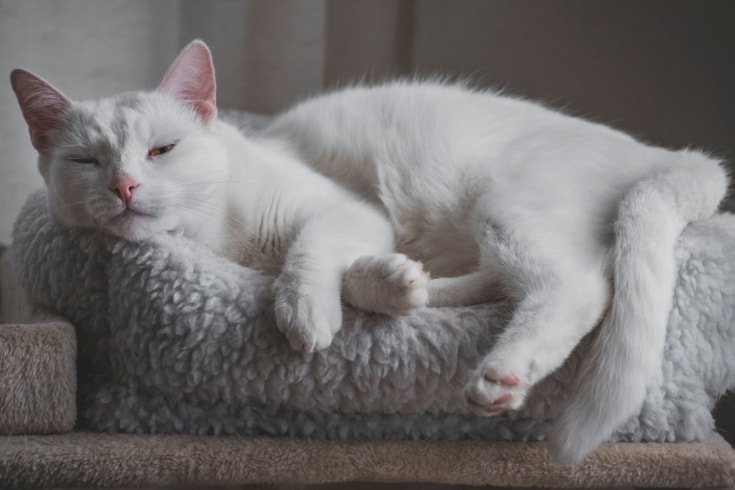
Cat sleep patterns and schedules differ from yours, although your feline friend has a circadian rhythm like humans do. Before you can train your cat to work to a different sleep pattern, it’s important to understand how cat sleep cycles work, the phases of cat sleep, and why individual cats can have different sleep patterns.
Keep reading to learn more about your furry friend’s fascinating sleep cycles!
Cat Sleep Cycle
As mentioned above, cats have a crepuscular sleep cycle that’s totally different from ours. Crepuscular animals are most active at dawn and dusk, sleeping for many short periods throughout the day and at night.
Interestingly, your cat sleeps for around 12 to 16 hours every day, which is a lot more than most average humans!
Natural Sleep-Wake Cycle Of Cats
All cats have what’s called a polyphasic sleep pattern, meaning they sleep in multiple short phases instead of one long stretch.
Impact Of Nocturnal Instincts
Your pet cat’s wild ancestors evolved as predators and are, therefore, naturally most active at night when small nocturnal prey animals, such as rodents, are around. In addition, although they can’t see in the dark, cats’ eyes have evolved to help them hunt efficiently in low-light conditions.
Distinguishing Features Of Cat Sleep
Your cat’s sleep-wake cycle can be divided into several different, distinct phases, each serving a specific purpose in their overall well-being.
These phases cover a range of sleep states, including light dozing with intact sensory awareness and the important REM sleep stage, during which learning and memory are consolidated in the brain.
Phases Of Cat Sleep
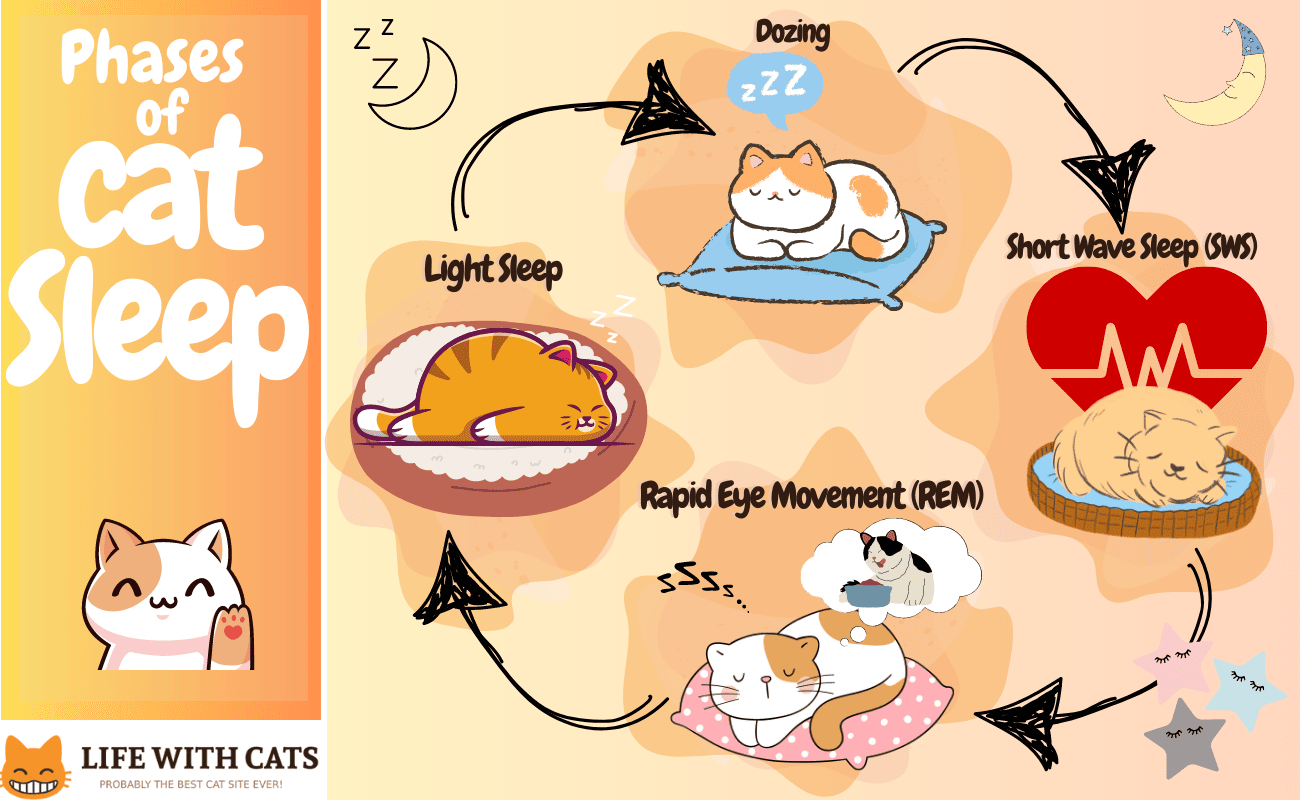
- Dozing: Cats spend a lot of time dozing, which is a light form of sleep. When your cat is dozing, she can wake quickly when startled or disturbed by external stimuli, such as a twittering bird or the sound of her lunch being prepared.
- Short Wave Sleep (SWS): SWS is the first phase of your cat’s deep sleep when her heart and respiration rates slow down.
- Rapid Eye Movement (REM): The REM sleep phase is when your cat dreams. The cat’s brain is highly active, but her body is pretty much paralyzed, so she can’t actually act out her dreams, although you’ll often see her paws twitching as if she’s chasing prey.
- Light Sleep: Following the REM sleep phase, the cat typically drifts back into a cycle of light sleep before waking up or starting the sleep cycle over again.
Duration Of Cat Sleep
Cats can spend varying lengths of time in each sleep phase, but most of the sleep time can be divided between dozing, SWS, and REM sleep. Compared with humans, cats generally have shorter REM cycles, which is probably why your furry friend enjoys more sleep time than you.
Variations In Cat Sleep Patterns
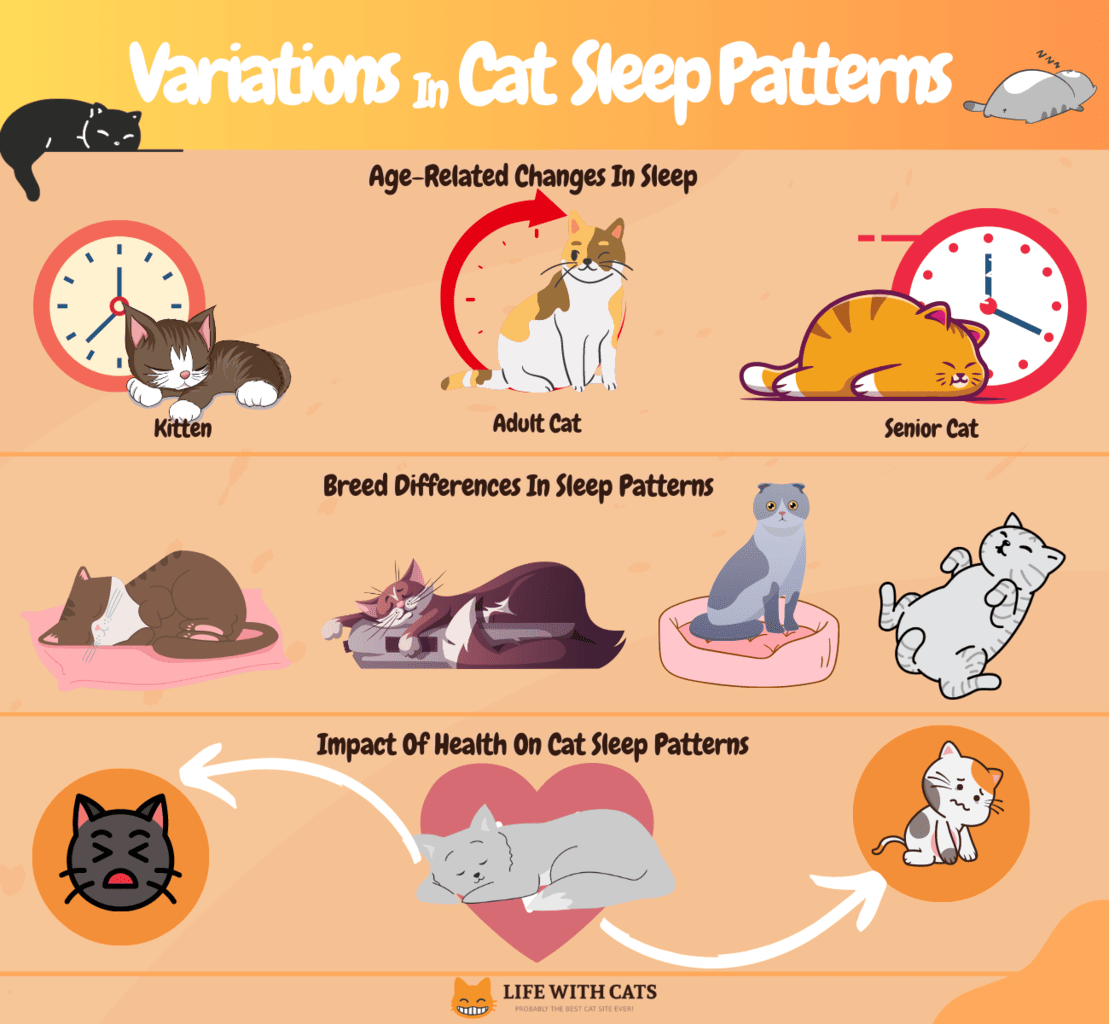
To confuse matters, not every cat experiences the same sleep pattern! Cat sleep cycles can vary widely between breeds and ages, and the animal’s health will greatly influence how much sleep she has.
Age-Related Changes In Sleep
Generally, kittens and senior cats tend to sleep more than adults. That’s because kittens need more sleep because their bodies are still growing and developing, whereas senior felines sleep more because they’re not as active and their metabolism slows down.
Breed Differences In Sleep Patterns
Interestingly, sleep patterns can vary between different cat breeds. For example, some breeds, such as Ragdolls, are laid-back and tend to sleep for longer hours than more active breeds, like the Bengal, which typically sleeps less.
Impact Of Health On Cat Sleep Patterns
If your cat is in pain or discomfort, she likely won’t sleep soundly, and her sleep cycle will be disrupted. In addition, some medical conditions can cause sleep duration and quality changes.
Nocturnal Nature Of Cats
As mentioned above, cats tend to be more active at night since they evolved as predators whose natural prey was most active during the night. I can vouch for that, as all my cats have preferred to go out at night, usually returning home after sunrise, presumably having spent the night chasing mice, some of which were left on my doorstep as gifts!
Cat Sleep Vs. Human Sleep
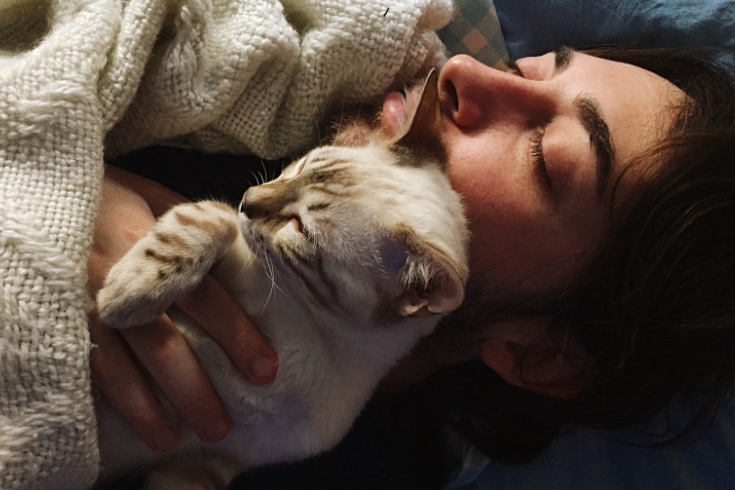
As explained earlier, your cat tends to sleep for more hours each day than you do at night, and she has a more fragmented sleep cycle. In addition, unless suffering from insomnia or some other medical condition, people typically enjoy longer periods of uninterrupted sleep with notably longer REM cycles when they dream.
Synchronizing Cat Sleep With Human Routine
Bearing in mind the above, you might be wondering how on earth you can effectively synchronize your cat’s sleep pattern with your own routine.
So, persuading your kitty to sleep through the night without disturbing you is undoubtedly challenging, but by adjusting your cat’s feeding times, exercise and playtime schedules, and creating an ideal sleeping environment, it can be done!
The Role Of Feeding Times
Cats are creatures of habit and routine, often arriving home or waking up at meal times as if they have some kind of internal alarm clock telling them it’s chow time!
You can use that to your advantage by feeding your cat at regular times to establish a routine.
Exercise And Playtime Scheduling
You can encourage your cat to sleep through the night by tiring her out with regular playtime and exercise sessions throughout the day.
For example, during the winter months, when my cats prefer to stay indoors, I make it part of their routine to spend a while playing laser pointer and feather wand games in the evening before bedtime. That usually ensures the cats sleep through until around 6 am without waking me up in the early hours.
Creating An Ideal Sleep Environment
If you want your cat to sleep through the night, you must provide her with a quiet, comfortable place where she feels safe and secure. If possible, pick somewhere away from traffic noise outside, drafts, and air conditioning units, and supply your pet with a cozy bed so she’s toasty warm.
Why Is It Important To Sleep Train A Cat?
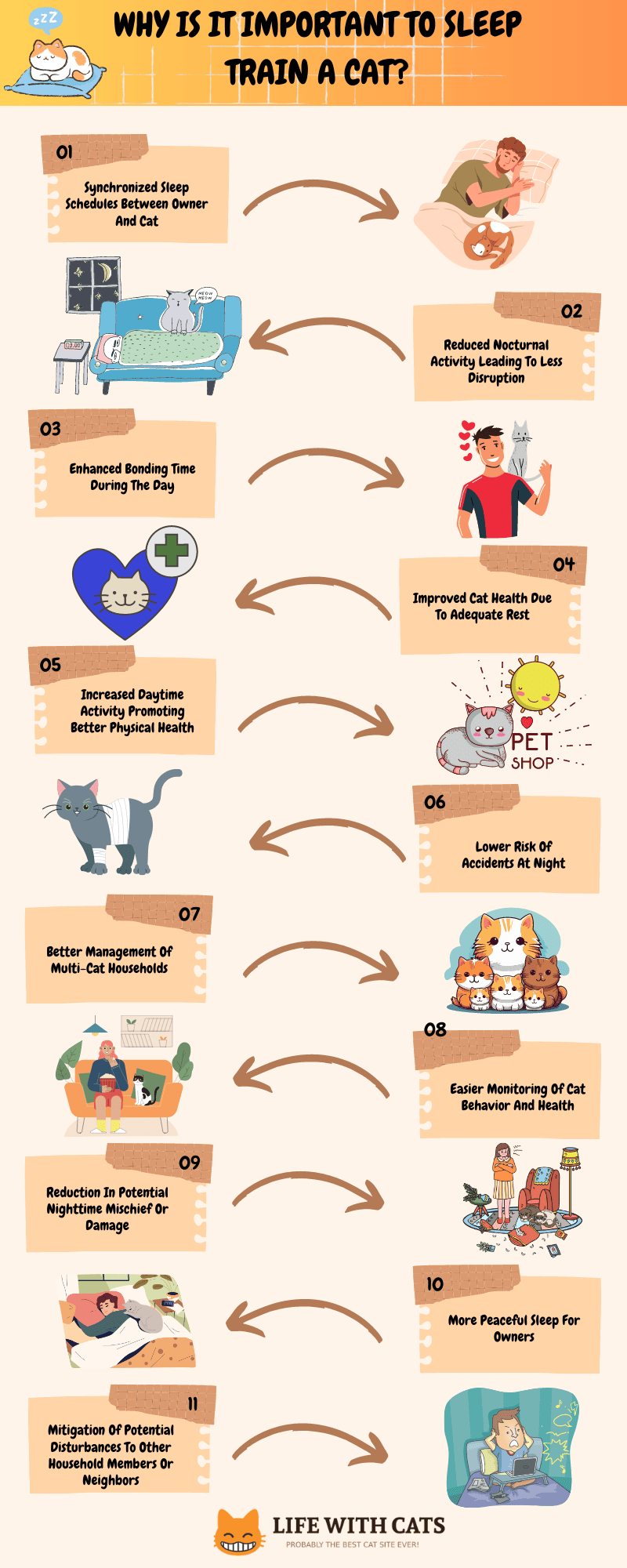
Training a cat to sleep at night is important because getting plenty of rest is essential for her physical health and well-being, and you’ll feel much better if you get to enjoy an undisturbed night’s rest, too. If you have an indoor cat, the likelihood of nighttime accidents in the home is less likely if your pet is fast asleep, and the potential for nighttime mischief and damage is greatly reduced.
In addition, if your cat is more active during the day, you’ll enjoy more playtime, training, and important bonding sessions with her.
Synchronized Sleep Schedules Between Owner And Cat
Synchronizing your cat’s sleep patterns with yours increases the chance of you spending quality time with your pet during the day. That can help to develop a stronger bond between you and reduce potential undesirable behaviors that could arise from a mismatch in your activity times.
Reduced Nocturnal Activity Leading To Less Disruption
As you know, cats are naturally crepuscular, meaning that they are most active at dawn and dusk. Sleep training your cat can prevent excessive nighttime activity, resulting in less disturbance and disruption for you and your family.
Enhanced Bonding Time During The Day
When your cat is well-rested, you will have many more opportunities for playtime and training sessions during the daytime, which will strengthen the bond between you and provide mental stimulation for your cat, which is essential for her overall happiness.
Improved Cat Health Due To Adequate Rest
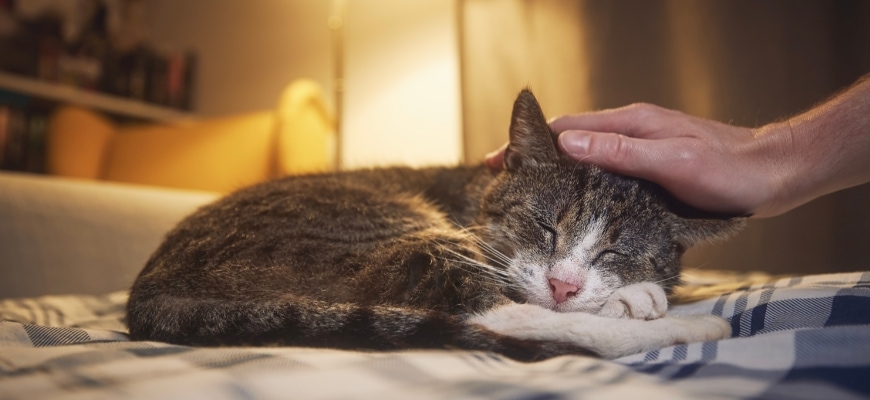
Just like you, cats need plenty of sleep for optimal health. Enjoying adequate rest helps to support the cat’s immune system, brain health, and overall vitality, and sleep training your cat ensures she gets all the rest she needs.
Increased Daytime Activity Promoting Better Physical Health
A cat that has enjoyed a good night’s sleep is far more likely to want to play during the daytime, promoting improved physical fitness and keeping her weight at a healthy level.
Lower Risk Of Accidents At Night
The last thing you want is for your cat to climb on furniture and jump onto counters during the night, potentially leading to accidents and injuries, and sleep training your cat can help to prevent that.
Better Management Of Multi-Cat Households
In a household with multiple cats, sleep training can help to prevent disturbances and conflicts during the night that might arise if the cats have different sleep schedules. If all your cats are peacefully sleeping throughout the night, your household will be undisturbed by squabbling or felines playing.
Easier Monitoring Of Cat Behavior And Health
If your cat is active during the day and asleep overnight, it will be easier for you to monitor her behavior and health. That means you’ll be best placed to seek veterinary advice if you spot a problem that might otherwise go undetected.
Reduction In Potential Nighttime Mischief Or Damage
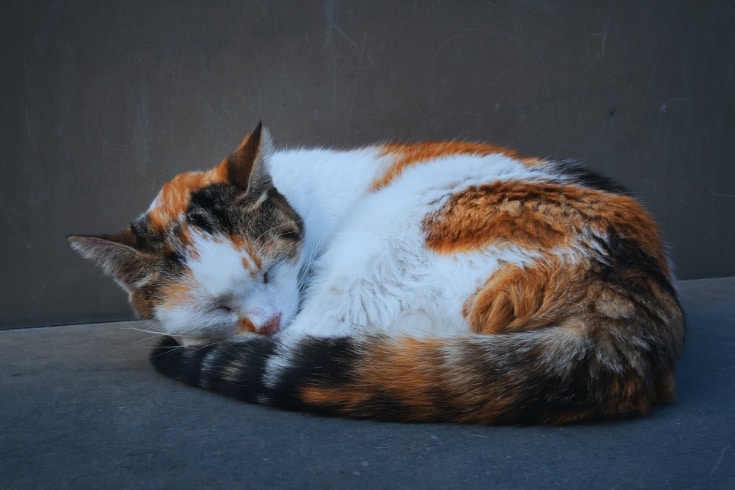
Cats are masters at getting into mischief when you’re not around to watch them. If your cat is fast asleep overnight, you can sleep soundly, knowing your furry friend won’t get up to anything she shouldn’t or damage any of your stuff.
More Peaceful Sleep For Owners
I know from experience how annoying it is to have your sleep disturbed by a cavorting cat leaping onto the bed or yowling to be let out at 3 am! Sleep training can mean you can enjoy an undisturbed night’s rest, so you awake in the morning feeling fresh and ready to face your day.
Mitigation Of Potential Disturbances To Other Household Members Or Neighbors
If you share your home with others, they won’t appreciate being woken in the wee small hours by a wandering cat scratching on her scratch post, and your neighbors will not be amused if your cat is out in their garden caterwauling or overturning plant pots.
Sleep training your cat can help to mitigate those potential disturbances to other household members or neighbors.
How Do I Train My Cat To Sleep At Night?
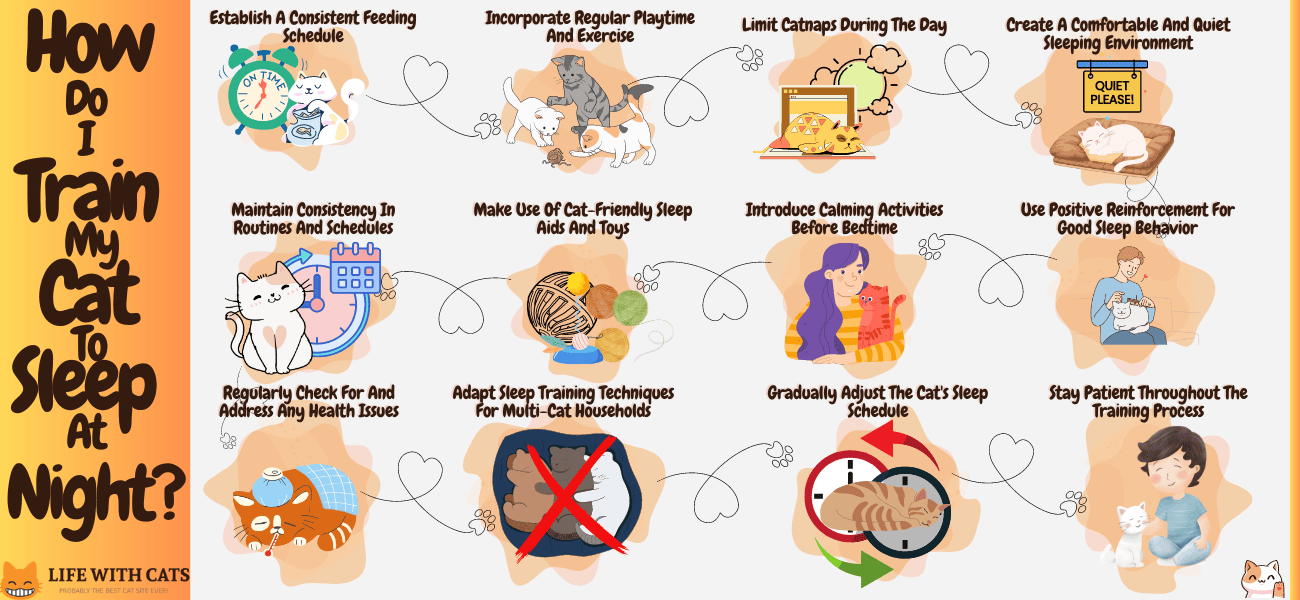
As you know, cats are most active at dawn and dusk, which can disrupt your sleep cycle, so training your feline friends to sleep at night benefits both you and your cat.
So, to help you and your family sleep easier, here are some top tips on how to train your cat to sleep at night!
Establish A Consistent Feeding Schedule
Cats are very much creatures of habit, and by feeding your cat at the same times each day, you can help to regulate her internal clock.
Try to feed your cat her last meal a couple of hours before you go to bed so she isn’t hungry, and get her used to having her breakfast in the morning.
Incorporate Regular Playtime And Exercise
Encourage your cat to have a playtime and exercise session shortly before you settle down for the night. That way, your cat won’t be full of energy and ready for a game or a hunt at bedtime.
Limit Catnaps During The Day
If your cat is awake for longer periods during the day, she’s more likely to sleep at night. So, incorporate a few playtimes, training sessions, and exercise periods throughout the day so your cat doesn’t get to take lots of catnaps.
Create A Comfortable And Quiet Sleeping Environment
Your cat won’t sleep at night if she’s disturbed by loud traffic noises outside or if her bed is in a drafty place. Create a comfortable, quiet sleeping environment for your cat by providing her with a cozy, warm bed and putting it somewhere peaceful.
Use Positive Reinforcement For Good Sleep Behavior
Positive reinforcement techniques are key to successful cat training, regardless of what you want your cat to learn. So, when your cat displays good sleep behavior, such as using the comfy bed, you set up for her in her designated sleeping space, be sure to reward her with treats and praise.
Introduce Calming Activities Before Bedtime
After enjoying an evening game or training session and her meal, try brushing your cat or simply holding her on your lap to calm her before you head off to bed and settle down for the night.
Make Use Of Cat-Friendly Sleep Aids And Toys
Sometimes, using a puzzle toy can occupy your cat’s mind and tire her out before bedtime, and calming pheromones can also be an effective way of getting your cat to sleep through the night.
Maintain Consistency In Routines And Schedules
Cats thrive on routines, so set a consistent schedule for meals, playtime, and bedtime to help your furry friend understand when it’s time to settle down for the night.
Regularly Check For And Address Any Health Issues
If you notice a sudden change in your cat’s regular sleep patterns, it could be caused by underlying health issues, so be sure to take your cat for regular veterinary check-ups, so you can spot and address any health problems that could be affecting your pet’s sleep.
Adapt Sleep Training Techniques For Multi-Cat Households
If you have multiple cats, giving each cat its own sleeping area is a good idea to prevent squabbling and territorial disputes that could disrupt their sleep.
Gradually Adjust The Cat’s Sleep Schedule
If your cat is used to living out at night, it’s unfair to expect her to change her sleep patterns immediately. Instead, you’ll need to gradually shift her feeding and playtimes to be closer to your bedtime, which will help align her activity with your sleep schedule.
Stay Patient Throughout The Training Process
Changing your cat’s sleep habits takes time, so be patient and consistent with your training efforts, and don’t get frustrated if progress is slow.
Identifying And Handling Cat Sleep Disorders
Like humans, cats can experience various sleep disorders, such as insomnia, sleep apnea, and even narcolepsy, which can affect their overall health, and understanding and being able to recognize those problems is critical when sleep training your cat.
This section explains some common sleep disorders that can affect cats and how to identify and manage them effectively.
Insomnia
Insomnia in cats refers to problems in falling asleep or staying asleep throughout the night. A cat with insomnia is restless, can be irritable, and might groom herself excessively.
Identification: If your cat constantly struggles to settle down for sleep at night, frequently wakes up throughout the night, or experiences an altered sleep schedule, she could be suffering from insomnia.
Solution: Try to create a calming bedtime routine for your cat, offer her a comfortable sleeping environment, and consult your vet in case your pet has underlying health issues you’re unaware of.
Sleep Apnea
Sleep apnea causes respiratory interruptions during sleep, causing your cat to wake up briefly throughout the night and resulting in poor sleep quality.
Identification: A cat with sleep apnea will snore loudly, her breathing will pause randomly while she’s asleep, and during the day, she will seem tired.
Solution: To diagnose sleep apnea, you should consult your vet, who might suggest options to manage the condition, including adjusting your cat’s sleeping positions, managing her weight, and fixing any potential breathing obstructions.
Restless Leg Syndrome
Just like in people, cats with restless leg syndrome suffer from involuntary leg movements while they are asleep, leading to disrupted rest and fatigue.
Identification: Watch your cat while she is sleeping. If your pet’s legs start to twitch, kick, or move involuntarily while she’s asleep, restless leg syndrome could be to blame.
Solution: One possible solution to your cat’s restless leg syndrome is to provide environmental enrichment and keep her busy and active during her waking hours.
Narcolepsy
Narcolepsy is when the cat suddenly and uncontrollably falls asleep during the daytime. Excitement usually triggers these episodes, which shouldn’t be confused with catnaps.
Identification: If your cat suddenly falls asleep unexpectedly during the day or collapses without warning, narcolepsy could be to blame.
Solution: If you think your cat is suffering from narcolepsy, you should consult your vet for a definitive diagnosis. Sometimes, creating a predictable, stable routine can help to manage and control narcolepsy symptoms, but your vet should guide you if your cat has this condition.
Nighttime Wandering
Cats with nighttime wandering tendencies tend to roam around and vocalize during the night, disrupting their sleep pattern and yours and driving your neighbors crazy!
Identification: Cats that are consistently noisy and active throughout the night are often experiencing nighttime wandering.
Solution: One effective solution to nighttime wandering is to keep your cat active and busy throughout the day with playtime, training sessions, and exercise to reduce nighttime restlessness. You might also want to give your cat toys to keep her entertained at night.
Excessive Daytime Sleepiness
Excessive daytime sleepiness is typically characterized by your cat having prolonged and unexplained periods of sleep throughout the day rather than simply catnapping.
Identification: Cats that suffer from excessive daytime sleepiness are typically lethargic, are disinterested in activities, and constantly sleep during waking hours.
Solution: Sometimes, adjusting your cat’s diet, routine, and playtimes can help to manage excessive daytime sleepiness. However, you should consult your vet in case any underlying health conditions are to blame.
Sleep Aggression
Sleep aggression is the term used to describe a cat’s aggressive behavior on waking, such as spitting, scratching, and biting.
Identification: If your cat reacts by spitting, scratching, or swatting at you when she is disturbed during sleep, sleep aggression could be the cause.
Solution: Always approach your cat quietly when waking her up, speaking gently to her and taking care not to startle her.
Abnormal Sleep-Wake Cycle
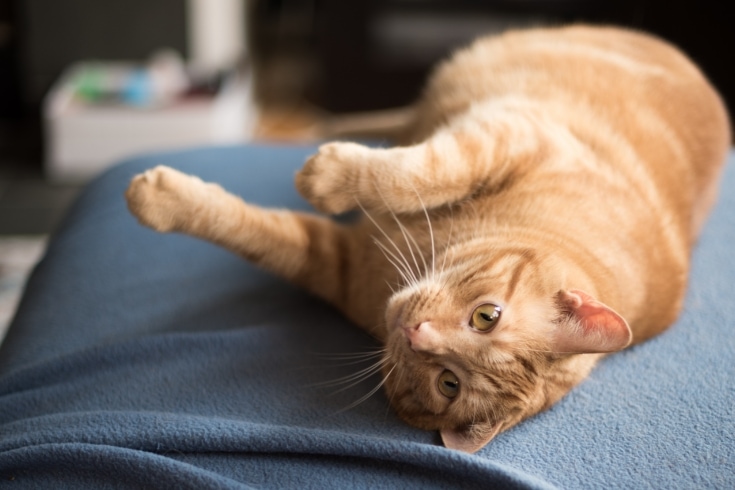
A cat with an abnormal sleep-wake cycle will probably be awake and active during the night and sleep excessively during the daytime, disrupting her natural sleep pattern.
Identification: If you notice that your cat is more active at night and tends to sleep more throughout the daytime, she could have an abnormal sleep-wake cycle.
Solution: To correct and reverse an abnormal sleep-wake cycle, try gradually adjusting your cat’s routine by playing with her, exercising her during the day, and taking steps to calm her when you settle down for the night.
Cognitive Dysfunction Syndrome In Older Cats
Cognitive dysfunction syndrome in senior cats is similar to dementia in people. This condition commonly causes confusion and changes in your cat’s sleep pattern, which can be distressing for both the cat and her owner.
I once had a senior cat of around 16 who began vocalizing loudly, especially at night when she would wander around the house yowling loud enough to wake the dead! My vet examined her and diagnosed cognitive dysfunction syndrome, which we treated successfully with drug therapy until old Chloe passed away from natural causes at the grand old age of 19 years.
Identification: If you have a senior cat that appears disoriented, exhibits altered sleep-wake cycles, and is forgetful, she could suffer from cognitive dysfunction.
Solution: Consult your vet for a proper diagnosis and be guided by their advice. Sometimes, you can manage the condition successfully by creating a comfortable, predictable environment and routine and supporting your pet with drug therapy, calming pheromone sprays and plug-ins.
Parasomnia Or Abnormal Behaviors During Sleep
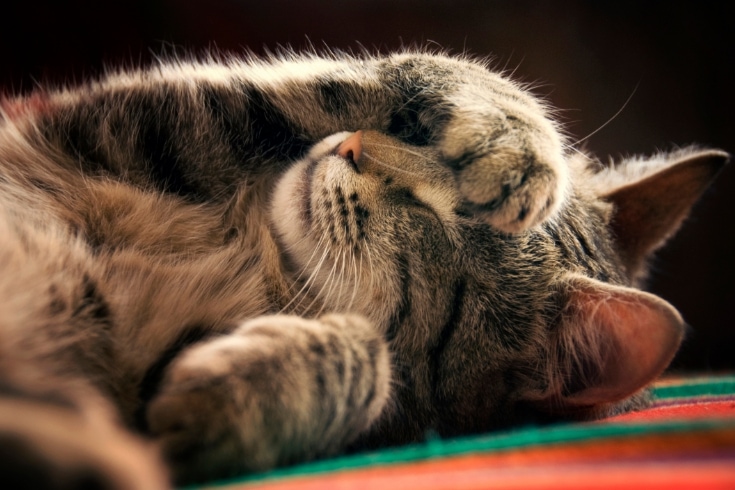
Parasomnia is the term used to describe any unusual behaviors exhibited by your cat during sleep, including meowing, aggression, and chewing.
Identification: Keep an eye on your cat while she’s sleeping, and look out for abnormal behavior and a lack of awareness of her surroundings, which could indicate parasomnia.
Solution: Start by asking your vet to rule out medical issues and consult with a professional animal behaviorist if necessary. You can also try providing a safe, secure sleeping environment for your cat.
Hypersomnia Or Excessive Sleep
Hypersomnia is when your cat sleeps excessively and very deeply for long periods, much longer than usual.
Identification: If your cat is always asleep, isn’t interested in playtime, training, or other activities, and you find it difficult to wake her, she could be suffering from hypersomnia.
Solution: First, consult your vet to rule out any possible undiagnosed health conditions. If your cat is given the all-clear, try engaging her in playtime and provide plenty of mental stimulation in the form of food puzzle games to encourage regular sleep patterns.
Sleep Disruption Due To Other Medical Conditions Like Arthritis, Hyperthyroidism, Etc.
Various medical conditions, including joint, arthritis, cognitive dysfunction syndrome, or hyperthyroidism, can all disrupt your cat’s sleep.
Identification:
If you notice your cat’s sleep is frequently disturbed, she shows signs of discomfort and has trouble settling into a comfortable sleeping position, an underlying medical condition could be to blame.
Solution: Ask your vet to examine your cat to check for potential underlying health problems and follow their recommendations for treatment. You can take steps to make your cat more comfortable by providing her with a snug bed and a heated mattress if applicable.
Additional Training Resources
Cat sleeping patterns and the problems that can be associated with them are fascinating topics. If you want to read more about the subject and learn more top tips to help your feline friend sleep more soundly, you could take a look at the following resources.
Top Books On Cat Behavior And Training
There are many books on cat behavior and training that you can use as additional resources to help you and your feline friend live a happy, enriched life together.
Understanding Cat Behavior: A Compassionate Guide to Training and Communication – Beth Pasek

This engaging book teaches you some practical tips and compassionate training tools so that you can learn to speak your cat’s language. The author provides valuable insight into why your cat does what she does and how you can manage her behavior. From communication to grooming, feeding, playing, and more, cat behavior is discussed from kittens to seniors and all the years between.
Decoding Your Cat: The Ultimate Experts Explain Common Cat Behaviors and Reveal How to Prevent or Change Unwanted Ones – American College of Veterinary Behaviorists

Written by leading experts in cat behavior from the American College of Veterinary Behaviorists, this book offers a comprehensive, easy-to-understand guide to decoding your feline friend. This book provides an in-depth understanding of why your cat misbehaves and how to fix it.
Preferred Online Cat Training Resources
Companion Animal Psychology
You’ll find lots of links to excellent veterinary cat training articles on this website: Companion Animal Psychology. There’s also a podcast, blog, and book recommendations.
Cats Protection
Cats Protection is the UK’s largest cat rescue charity, with hundreds of volunteers and fosterers nationwide. In fact, I got both my cats from them as kittens a few years ago. Cats Protection has an excellent website full of helpful articles on cat training and care, and they have a very active Facebook presence.
VCA Animal Hospitals
VCA has an excellent website packed with articles and blog posts on cat behavior and training written by qualified veterinary experts.
Best Cat Sleep Aids And Toys
Sometimes, it’s effective to encourage your cat to sleep at night by providing her with a selection of toys to tire her out before bedtime, and puzzle toys, in particular, can be highly effective at tiring your cat mentally, leaving her ready for sleep.
Cat Amazing Sliders Interactive Treat Maze & Puzzle Cat Toy

This puzzle toy comprises three sections that slide to change up the puzzle. The toy is ideal for evening playtime because it encourages your cat’s natural hunting instincts, leaving her tired, satisfied, and ready for sleep.
The toy holds toys as well as treats and is made from industrial strength, double-sided cardboard, and features a plant-based gloss coating for your kitty cat’s safety.
TRIXIE Cat Activity Brain Mover, Strategy Game

This interactive cat puzzle features four modules requiring different skills and provides your cat with mental and physical exercise. The toy is suitable for cats of all ages and features non-slip rubber feet that keep the base in place while your cat plays.
FAQs
Why Is My Cat Active During The Night?
As mentioned earlier, cats are naturally crepuscular animals, meaning they are most active at dawn and dusk. That behavior is thoughts to be because of the cat’s natural hunting instincts, as their prey is generally active during these times. In addition, cats have excellent night vision, so it’s easy for them to find their way around and hunt in low-light conditions.
Even though your cat is domesticated, she still retains that natural behavior, making her more active and playful at night.
How Long Does It Take To Change A Cat’s Sleep Schedule?
Although you can change a cat’s sleep schedule, how long it takes depends on the individual cat and how adaptable she is. It might take anywhere from a few days to a couple of weeks to see any significant change in your cat’s sleep patterns, so you will need to be patient and consistent in your approach when trying to modify your pet’s sleep schedule.
Is It Natural For Cats To Sleep Throughout The Night?
Although cats are crepuscular and, therefore, more active at dawn and dusk, it’s not uncommon for them to sleep throughout the night. For example, my cats have adapted their sleep patterns to some extent to match mine, especially during the winter when it’s cold and dark outside and they don’t want to go out.
Can Elderly Cats Also Be Trained To Sleep At Night?
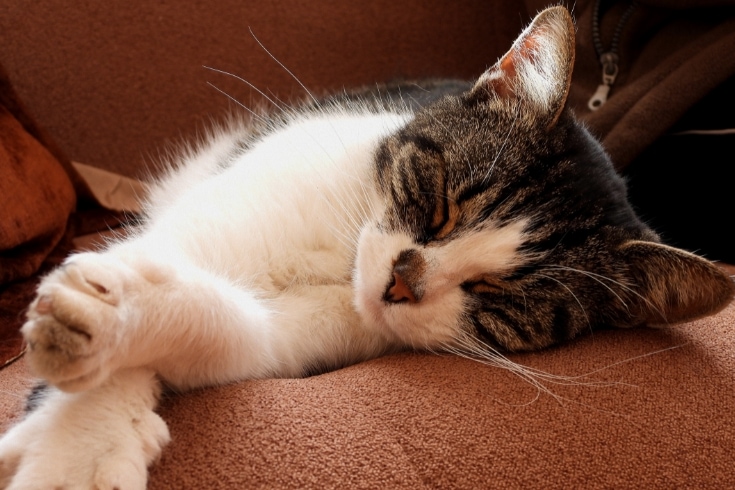
Yes, it is possible to train an elderly cat to sleep at night, although that might take longer, as the cat probably already has an established routine that’s hard to change. Try making only gradual adjustments to your cat’s routine and provide her with a comfortable, quiet sleeping environment to help her adjust to sleeping through the night.
Will Changing My Cat’s Feeding Schedule Affect Its Sleep Cycle?
Making changes to your cat’s feeding schedule can influence her sleep cycle to some extent. Cats typically associate feeding times with activity, so changing her feeding schedule might also lead to changes in your pet’s activity patterns. That said, it might not completely change your cat’s natural tendency to be more active during dawn and dusk.
What Type Of Exercises Can Help My Cat Sleep Better?
I have always found that encouraging my cats to play in the evening can help them expend their excess energy and encourage them to sleep more during the night. I use toys that simulate hunting behavior, such as laser pointers and feather wands, as I find those to be the most effective. However, be careful not to overstimulate your cat right before bedtime, as that strategy can sometimes backfire, and you end up with a cat with the zoomies!
What Role Does The Sleeping Environment Play In A Cat’s Sleep Cycle?
Cats prefer quiet, dark, warm, cozy sleeping areas that are well away from disturbances, and providing such an environment plays a crucial role in your cat’s sleep cycle.
Are There Any Specific Sleep Aids Or Toys That Can Help My Cat Sleep At Night?
Keeping your cat busy during the day with interactive puzzle toys can potentially encourage her to rest more at night, and providing your cat with a warm, soft bed can encourage comfort and relaxation. You might find that a spray or plug-in pheromone product placed in your cat’s sleeping area helps calm and relax your cat at night.
Is It Possible To Train More Than One Cat At A Time To Sleep At Night?
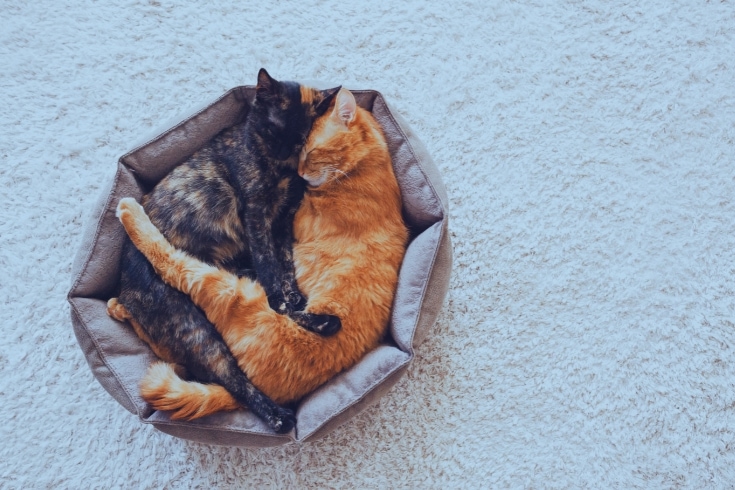
In theory, it is possible to train more than one cat at a time to sleep at night. However, persuading all the cats to adjust to a new sleeping schedule requires more effort and consistency since each cat has a different personality and preferences.
You will probably find that one cat will disturb the others during the night, which is what happens with my two feline friends.
How Do I Address A Cat’s Sleep Disorder While Training It To Sleep At Night?
If you think your cat has a sleep disorder, such as excessive daytime sleepiness or insomnia, we strongly recommend you consult your vet for advice. Your vet will assess your cat’s overall health and behavior to see if any underlying medical issues affect her sleep and give you the appropriate advice on how to proceed with your cat’s training.
Are There Any Potential Health Issues That Can Affect A Cat’s Sleep Schedule?
Several potential health issues can affect a cat’s sleep schedule, including pain, discomfort, anxiety, or stress, which can disrupt your pet’s sleep patterns. Monitor your cat’s behavior closely and speak to your vet if you notice any significant changes in your pet’s sleep habits or behavior.
What Should I Do If My Cat Resists The Training To Sleep At Night?
Some cats can resist training to sleep at night, and if your cat isn’t keen to change her behavior, you must be patient and persistent. Try to provide lots of activities during the evening to tire your cat ou,t and create a comfortable sleeping environment for her.
Making gradual changes to your cat’s environment and routine can take time to show results, but if you are concerned about your pet’s resistance or think she has underlying health issues, always speak to your vet for advice before continuing with training.
Conclusion
Training your cat to sleep at night has many benefits for both the cat and the owner. A sound night’s rest leaves you and your family feeling refreshed and ready to face the day and helps to keep your cat healthy and happy.
Start by establishing a regular routine before bedtime, including feeding and exercising your cat so that she goes to bed feeling tired and isn’t hungry. Try to keep your cat active throughout the day and limit the number of catnaps she takes so that she’s ready for sleep at night. Provide your cat with a quiet, warm, comfortable sleeping area where she won’t be disturbed, and have your vet check your cat regularly for any underlying health conditions that might prevent her from sleeping soundly.
Throughout your cat’s sleep training, you must be consistent in your approach and patient, especially if you are training an older cat that is set in her ways and might find change challenging.
A well-rested cat is more likely to enjoy good health and will be more receptive to training, playtimes, and exercise sessions during the day, helping you to bond more deeply with your beloved pet.